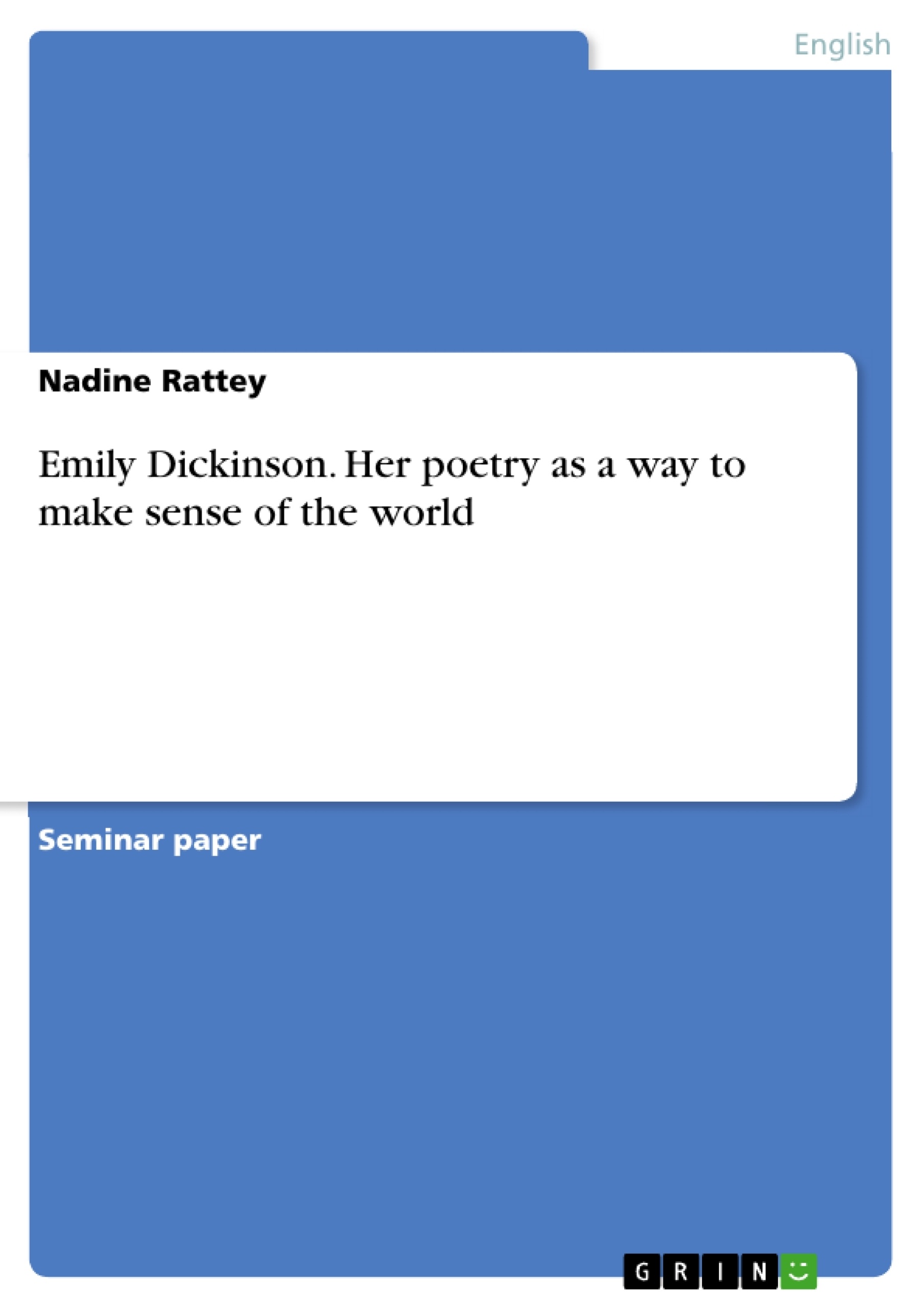As the first female poet who was included into the regularly male canon of poetry, Emily Dickinson is one of the few popular American poets of the 19th century. Another equally influential contemporary American poet may only be Walt Whitman, whose
main work was the poetry collection Leaves of Grass of 1855.
Emily Dickinson's collection of poems contains nearly 1800 pieces. They cover a variety of different topics. The motifs of life, love, marriage, nature, faith and death run through her poems like a thread.
Dickinson has her very own view on the human ability to make sense of the world. Looking at the world theologically more liberal than other contemporary authors, because she is estranged from religious beliefs, she doubts the ideals of adjustment and perfection and thus tries to attain truth by holding the view that the world is in constant progression.
In order to describe this view appropriately, I will first of all give an overview of biographical, historical and cultural facts of Emily Dickinson. After providing this background information, I will introduce some of Emily Dickinson's poetic themes and
strategies and analyse selected poems of her. The analyses are intended to underline my findings and serve to give an overview of the stylistic elements Dickinson uses to illustrate her view on the human ability to make sense of the world. I will conclude my outcome by explicating to what extent Emily Dickinson's poetry has been a poetic contribution to American Literature until today.
Table of Contents
- A. Introduction: Dickinson's approach to make sense of the world...
- B. Emily Dickinson: Influence and Strategies
- I. Biographical, Historical and Cultural Facts.
- II. Poetic Themes and Strategies
- 1. Dickinson's Attitude towards Live, Love and Marriage Illustrated by Poem #199: “I'm “wife” – I've finished that”
- 2. The Relationship Between the Human and the Natural World Illustrated by Poem #328: “A Bird came down the Walk”.
- 3. Dickinson's investigative Religious Poetry Illustrated by Poem #465: “I heard a Fly buzz when I died -”.
- C. Conclusion: Dickinson's Poetic Contribution to American Literature .
Objectives and Key Themes
This text explores Emily Dickinson's unique approach to understanding the world through her poetry. It aims to analyze her life and the cultural influences that shaped her worldview, focusing on her poetic themes and strategies. The text examines three of Dickinson's poems in detail, demonstrating how she used her poetry to express her doubts and search for truth. The main themes explored in the text include: * **Dickinson's Personal and Societal Perspective**: This includes her unconventional views on marriage, love, and the role of women in society. * **The Relationship Between Humanity and Nature**: The text examines how Dickinson perceived and expressed her connection with the natural world. * **Dickinson's Exploration of Faith and Religion**: The author explores Dickinson's religious beliefs and how they influenced her poetry. * **Dickinson's Poetic Style and Strategies**: The text analyzes Dickinson's unique poetic style and strategies, particularly her use of unconventional language, capitalization, and rhyme schemes.Chapter Summaries
A. Introduction: Dickinson's approach to make sense of the world
This chapter introduces Emily Dickinson as a pioneering female poet in 19th-century America, highlighting her prolific work and unique perspective on life, love, marriage, nature, faith, and death. The author explains that Dickinson's liberal theological approach, marked by her estrangement from traditional religious beliefs, led her to question conventional ideals and embrace the notion of a world in constant progression.B. Emily Dickinson: Influence and Strategies
This chapter delves into the biographical, historical, and cultural influences that shaped Emily Dickinson's worldview. It examines her upbringing in a Puritan family, her isolation from the world, and her resistance to societal expectations for women during her era. The author emphasizes the influence of Transcendentalism and Romanticism on Dickinson's thinking.I. Biographical, Historical and Cultural Facts
This sub-chapter provides detailed biographical information about Emily Dickinson, including her upbringing, her social isolation, and her lifelong writing career. It discusses her early life in Amherst, Massachusetts, her decision to remain unmarried, and her gradual withdrawal from society, particularly after the deaths of her parents. The chapter connects her seclusion to various factors, including agoraphobia, unrequited love, and her desire to escape societal constraints. The author then explores the societal expectations placed on 19th-century American women, highlighting Dickinson's resistance to these norms in her search for mental and spiritual freedom.II. Poetic Themes and Strategies
This sub-chapter focuses on Emily Dickinson's distinctive poetic strategies, contrasting them with those of other popular 19th-century American poets. The author highlights her use of common meter, unconventional rhyme schemes, and stylistic devices like dashes, slant rhymes, and enjambment. This chapter emphasizes her unique approach to language and punctuation to create tonal impressions.1. Dickinson's Attitude towards Live, Love and Marriage Illustrated by Poem #199: “I'm “wife” – I've finished that”
This section analyzes Poem #199, "I'm "wife" - I've finished that", to illustrate Emily Dickinson's views on marriage and its associated societal roles. The author examines the poem's language and imagery to explore the speaker's complex feelings towards the institution of marriage.Keywords
The main keywords and focus topics of this text include: Emily Dickinson, American poetry, 19th-century literature, Transcendentalism, Romanticism, Puritanism, poetic themes, poetic strategies, marriage, love, nature, religion, faith, death, isolation, societal expectations, women's roles, literary analysis. The text delves into Dickinson's unique worldview and her use of poetry to explore her personal experiences and societal realities.- Quote paper
- Nadine Rattey (Author), 2014, Emily Dickinson. Her poetry as a way to make sense of the world, Munich, GRIN Verlag, https://www.grin.com/document/294892




